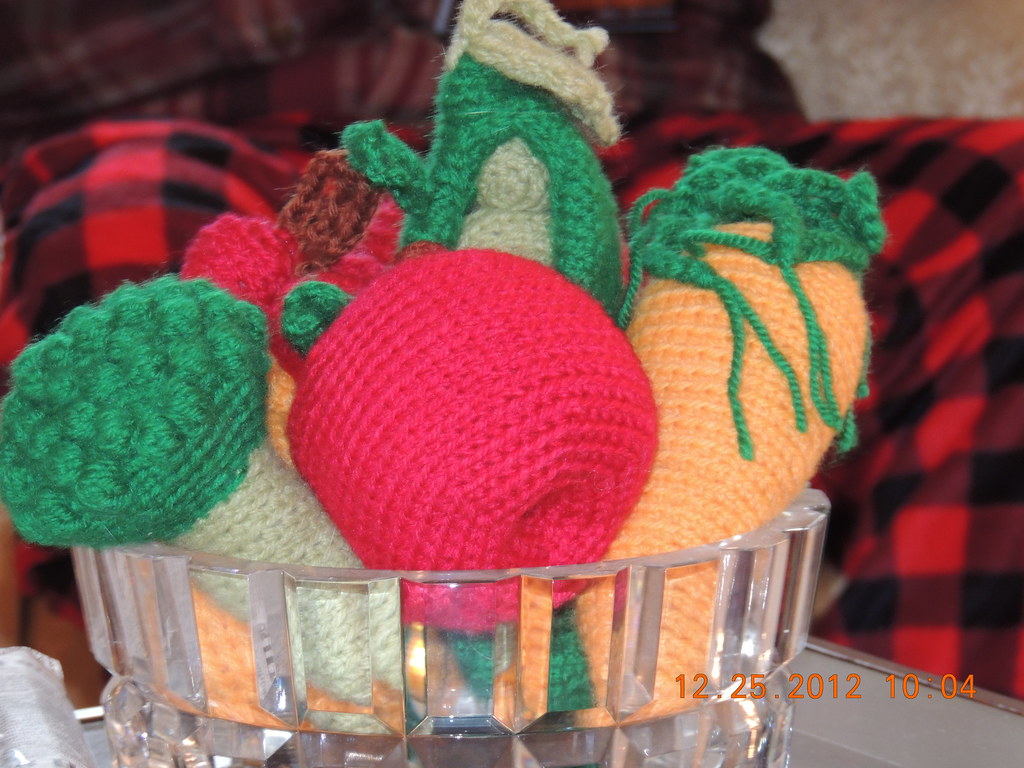 My husband just brought the June 2013 issue home. He burst in the door with this frenetic look on his face and slapped the cover in front of me. “Look! It’s what you do!” Michael was referring to the fact that I’ve been designing a series of crochet foods, the latest of which are Sweet Strawberries and Outrageous Orange.
My husband just brought the June 2013 issue home. He burst in the door with this frenetic look on his face and slapped the cover in front of me. “Look! It’s what you do!” Michael was referring to the fact that I’ve been designing a series of crochet foods, the latest of which are Sweet Strawberries and Outrageous Orange.
If you haven’t seen the cover yet, Kate Jenkins, a fiber artist, created the absolutely stunning display at the right. Called Wool Chow Mein Fake-Away, there’s also really comprehensive article on her work at the Smithsonian website. It doesn’t surprise me that Smithsonian would use her crochet-based art as cover-art, because the Smithsonian has had a relationship with crocheters in the past.
 |
| Some of the many pieces crocheted for the reef: mine are the orange ones in the middle. |
The Smithsonian and I have a deeper relationship than just our mutual appreciation for food as art. In 2010 I, along with many other crocheters in the greater Washington DC area, participated in the Smithsonian Display of the Hyperbolic Crochet Coral Reef. The project works to get local communities engaged and learning about Coral Reef Destruction and Preservation through a mix of community interaction, art and education. For a couple of weeks my room mate and I frenetically crocheted hyperbolic shapes to help create the absolutely massive coral reef that dominated the ocean hall a the Smithsonian’s Museum of Natural History.
What I love about the Smithsonian June 2013 cover is not only the creative use of crochet as art (because well, it’s cool and a little mind-bending, because handicrafts like crochet and knitting rarely get the attention that other forms of art do), but the way it touches on the tension in values in America today. Crochet (and knitting and other handicrafts) are experiencing a wonderful revival, as people push back against our technology driven society by going back to the hobbies and handicrafts of their parents or grandparents. In a similar way, many people are trying to get in better touch with where their food comes from – either growing their own, seeking organic alternatives, or participating in things like farm shares.
Kate Jenkins art, in a way, combines these converging concerns, in a lighthearted way that engages a viewer. There’s the moment of thinking, oh, a box of chow mein, before the viewer goes, “wait a moment – is that fake?” And suddenly, the tension between ‘fake food’ and ‘real food’ gets blurred, and the viewer has to really think about the piece – the word it took to make it look so realistic and authentic, and the time it took to make the display. Just like the time it takes to make and grow real food, and the work that is put into fruits and vegetables, shrimp and noodles, before the food makes it onto the plate.
The Crochet Cornucopia series, with my Strawberries, Oranges (and coming soon, Watermelon, Cherries and Carrots), is trying to work toward a same goal. A person could just purchase toy food from the toy store, or buy plastic food to fill a fruit bowl. By making the fruits and vegetables themselves, you are declaring that it’s important to have quality items that will last years. You want homemade fruit that will look beautiful. You want toys for your children where you don’t have to worry about them teething off the paint or have stuffing fall out. You want quality things that reflect the time and care and thought you put into making them.
Check out the Crochet Cornucopia patterns on my Ravelry page.










